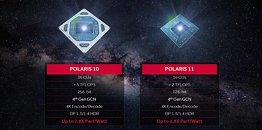Raevenlord
News Editor
- Joined
- Aug 12, 2016
- Messages
- 3,755 (1.24/day)
- Location
- Portugal
| System Name | The Ryzening |
|---|---|
| Processor | AMD Ryzen 9 5900X |
| Motherboard | MSI X570 MAG TOMAHAWK |
| Cooling | Lian Li Galahad 360mm AIO |
| Memory | 32 GB G.Skill Trident Z F4-3733 (4x 8 GB) |
| Video Card(s) | Gigabyte RTX 3070 Ti |
| Storage | Boot: Transcend MTE220S 2TB, Kintson A2000 1TB, Seagate Firewolf Pro 14 TB |
| Display(s) | Acer Nitro VG270UP (1440p 144 Hz IPS) |
| Case | Lian Li O11DX Dynamic White |
| Audio Device(s) | iFi Audio Zen DAC |
| Power Supply | Seasonic Focus+ 750 W |
| Mouse | Cooler Master Masterkeys Lite L |
| Keyboard | Cooler Master Masterkeys Lite L |
| Software | Windows 10 x64 |
AMD's upcoming RX 500 series of graphics cards is not going to set the world on fire with its feature-set. Essentially rebrands of AMD's mainstream Polaris GPUs used in current-generation RX 400 series, these have recently seen a slight delay on its time to market - now set at April 18th.
While architecture-level adjustments to this new series of cards so as to improve performance seem to be off the table, AMD is apparently looking to take advantage of manufacturing maturing and process improvements. The original Polaris 11 and Polaris 10 chips were manufactured using the Low Power Early (LPE) process, which looks to balance availability, yields, and time-to-market with performance and power. New reports peg the new dies to carry the Polaris 21 and Polaris 20 monikers, and will feature higher clocks on account of the new Low Power Performance (LPP) process.


As to the higher clocks, these apparently are only responsible for bridging the gap between the RX 480's reference and custom boards. The RX 580 will reportedly carry a 1340 MHz clock (74 MHz more than the reference RX 480), with the RX 570 carrying a much less significant 38 MHz increase over its RX 470 counterpart. The Radeon RX 560 will apparently make do with a clock speed of 1287 MHz.
These clock improvements only go so far as to allow AMD to claim a measure of increased performance comparing to their previous-generation, same architecture, one-year-old graphics cards. Vega is the only product from the company which will have some semblance of originality. A shame AMD didn't adopt some of Vega's refinements to its mainstream graphics cards.
View at TechPowerUp Main Site
While architecture-level adjustments to this new series of cards so as to improve performance seem to be off the table, AMD is apparently looking to take advantage of manufacturing maturing and process improvements. The original Polaris 11 and Polaris 10 chips were manufactured using the Low Power Early (LPE) process, which looks to balance availability, yields, and time-to-market with performance and power. New reports peg the new dies to carry the Polaris 21 and Polaris 20 monikers, and will feature higher clocks on account of the new Low Power Performance (LPP) process.


As to the higher clocks, these apparently are only responsible for bridging the gap between the RX 480's reference and custom boards. The RX 580 will reportedly carry a 1340 MHz clock (74 MHz more than the reference RX 480), with the RX 570 carrying a much less significant 38 MHz increase over its RX 470 counterpart. The Radeon RX 560 will apparently make do with a clock speed of 1287 MHz.
These clock improvements only go so far as to allow AMD to claim a measure of increased performance comparing to their previous-generation, same architecture, one-year-old graphics cards. Vega is the only product from the company which will have some semblance of originality. A shame AMD didn't adopt some of Vega's refinements to its mainstream graphics cards.
View at TechPowerUp Main Site
Last edited:







